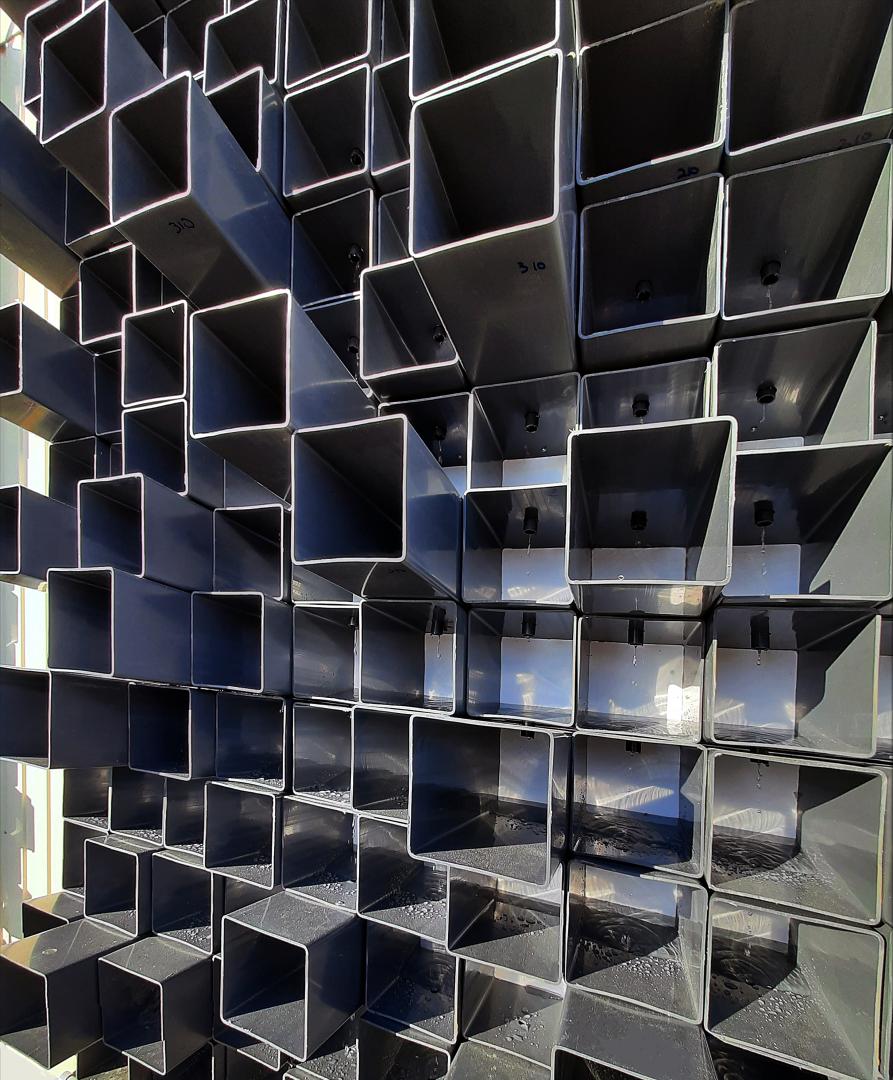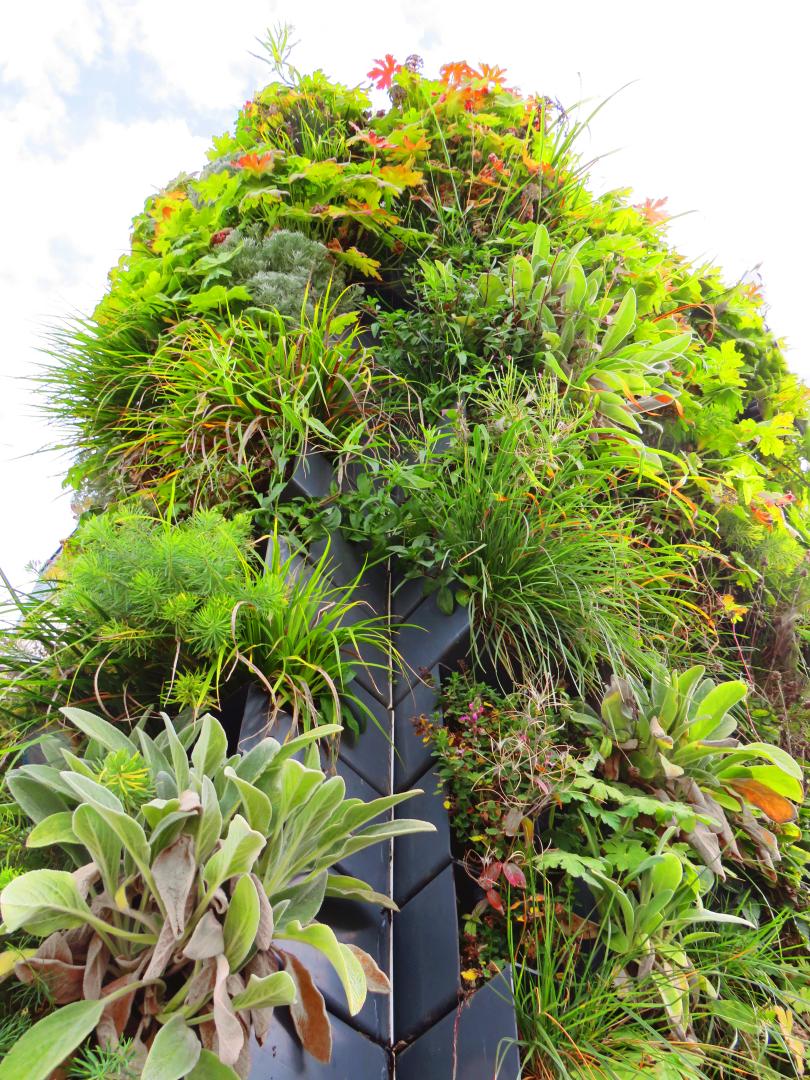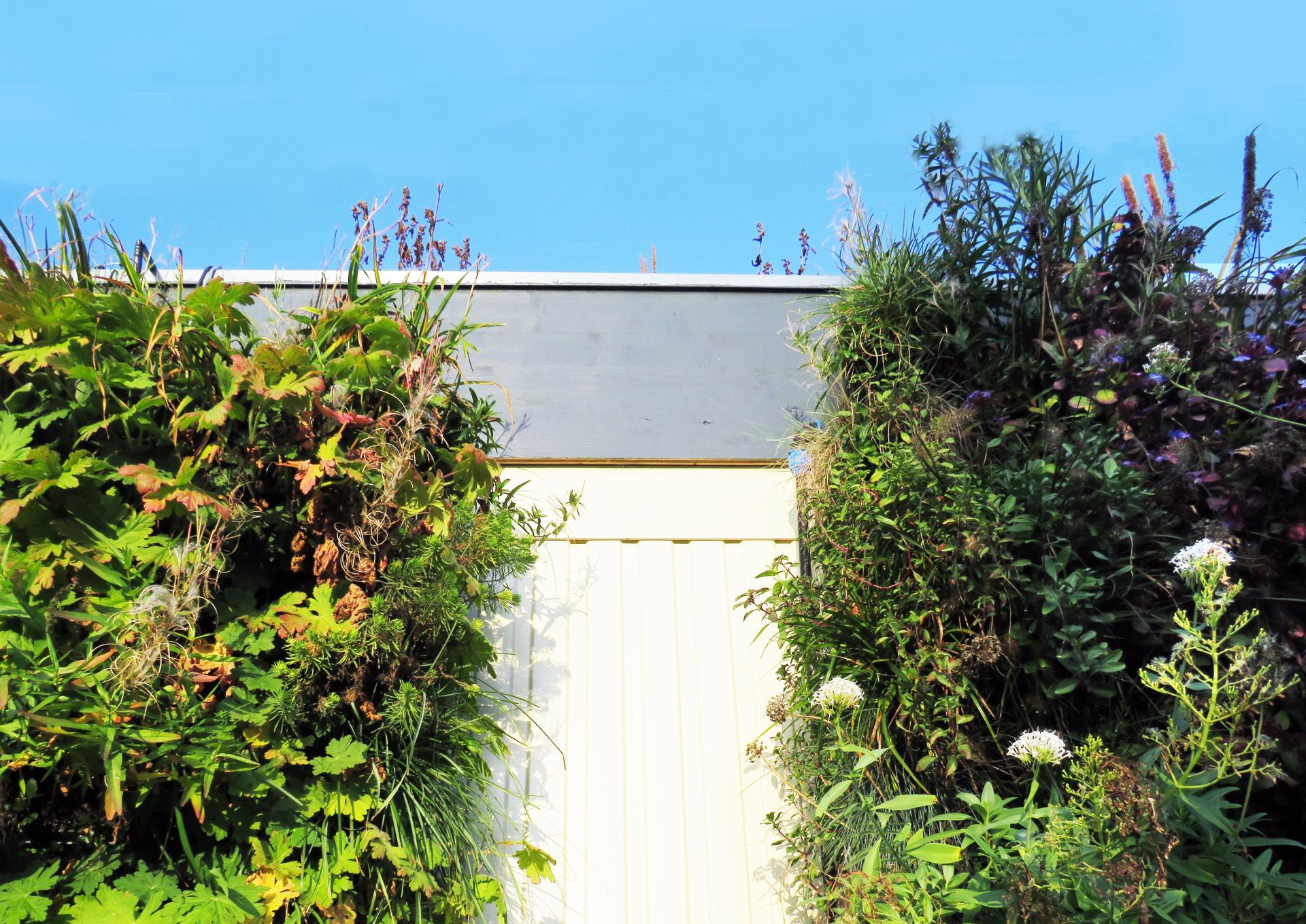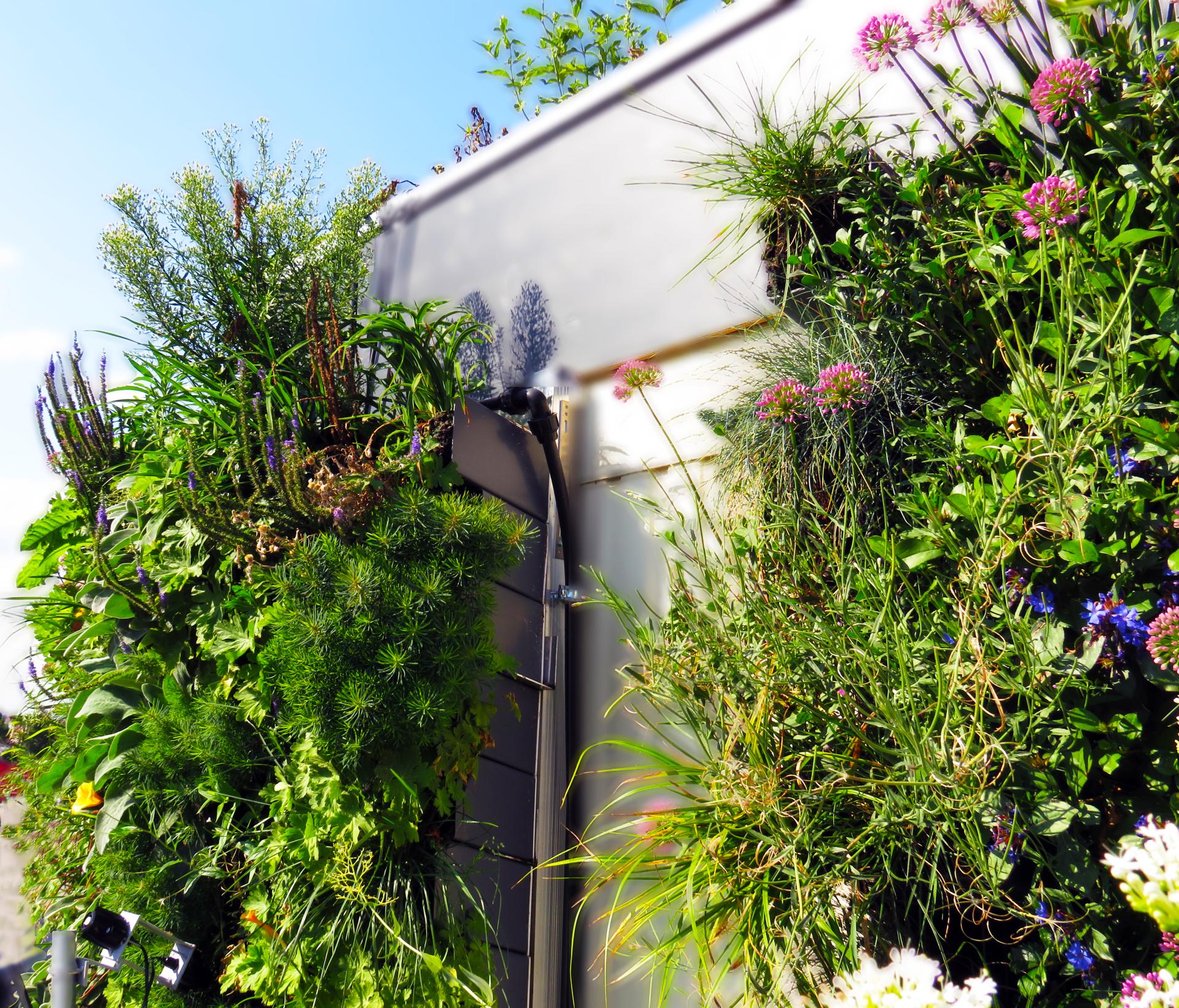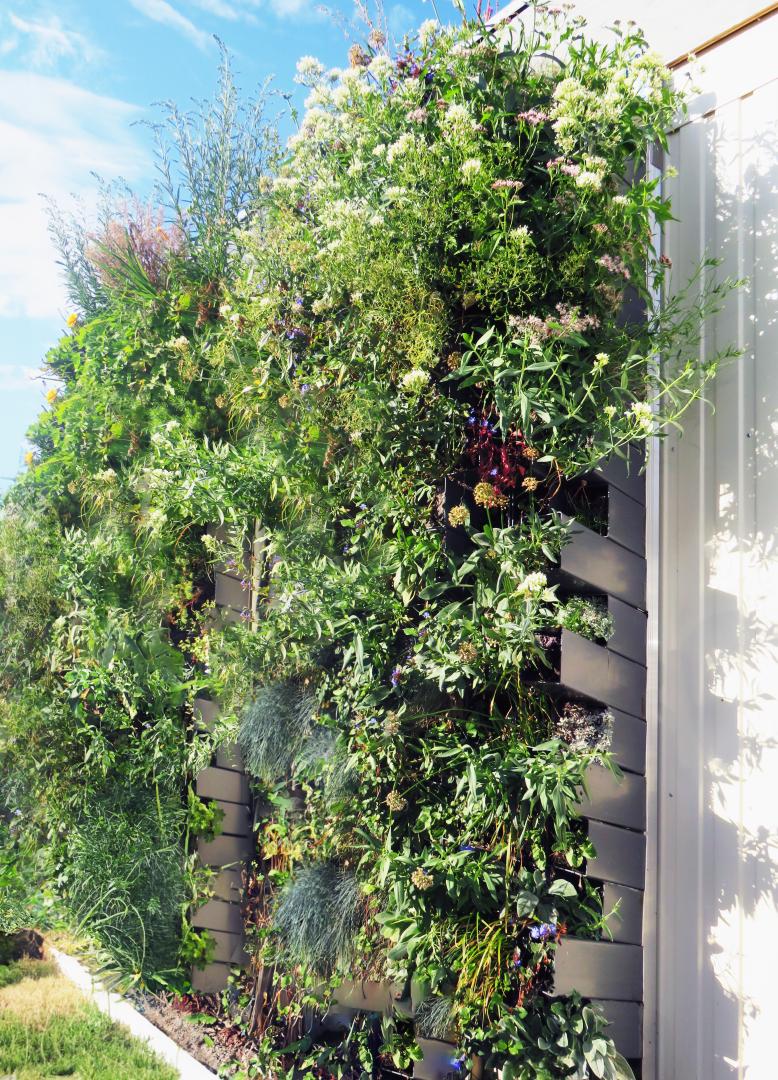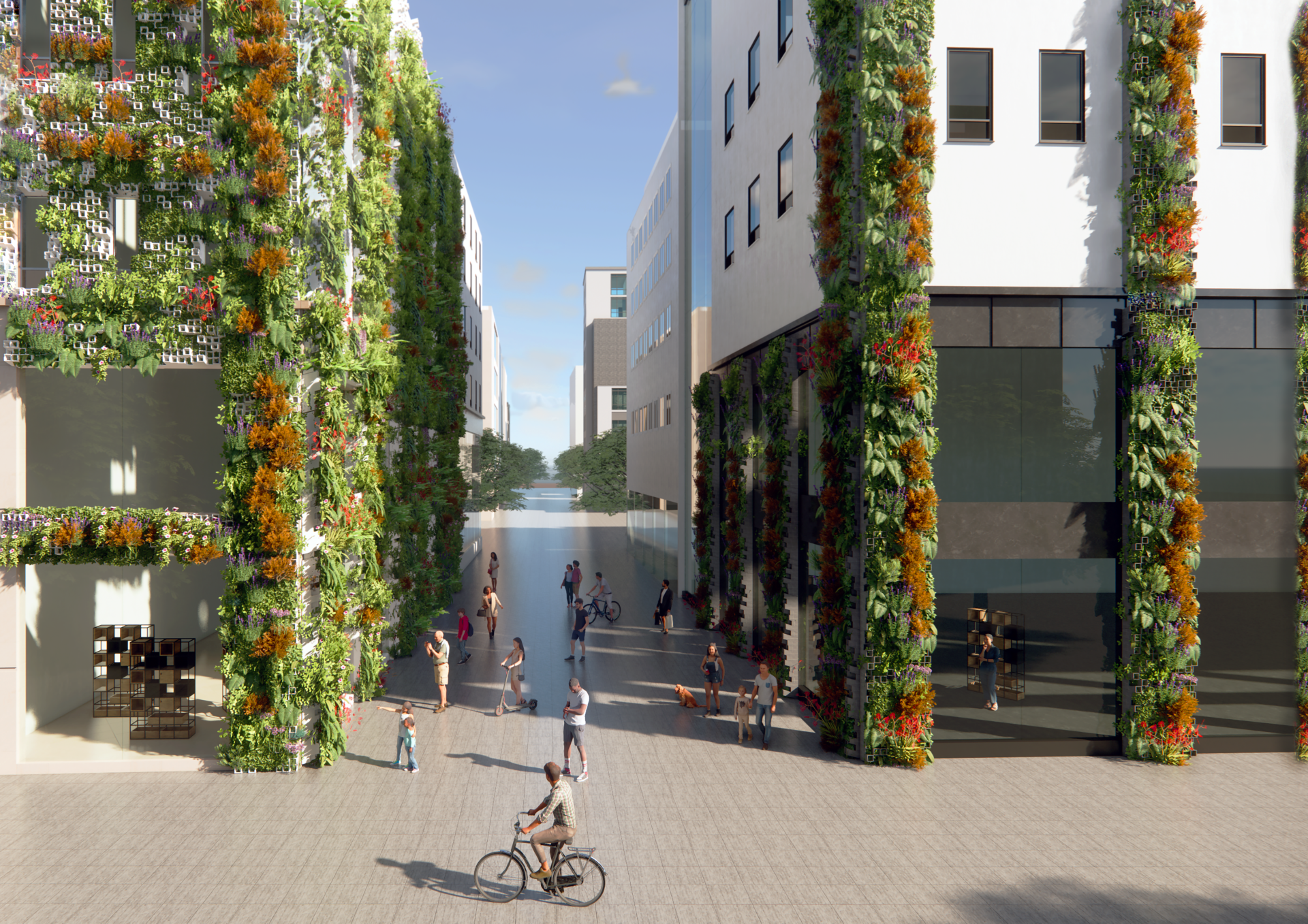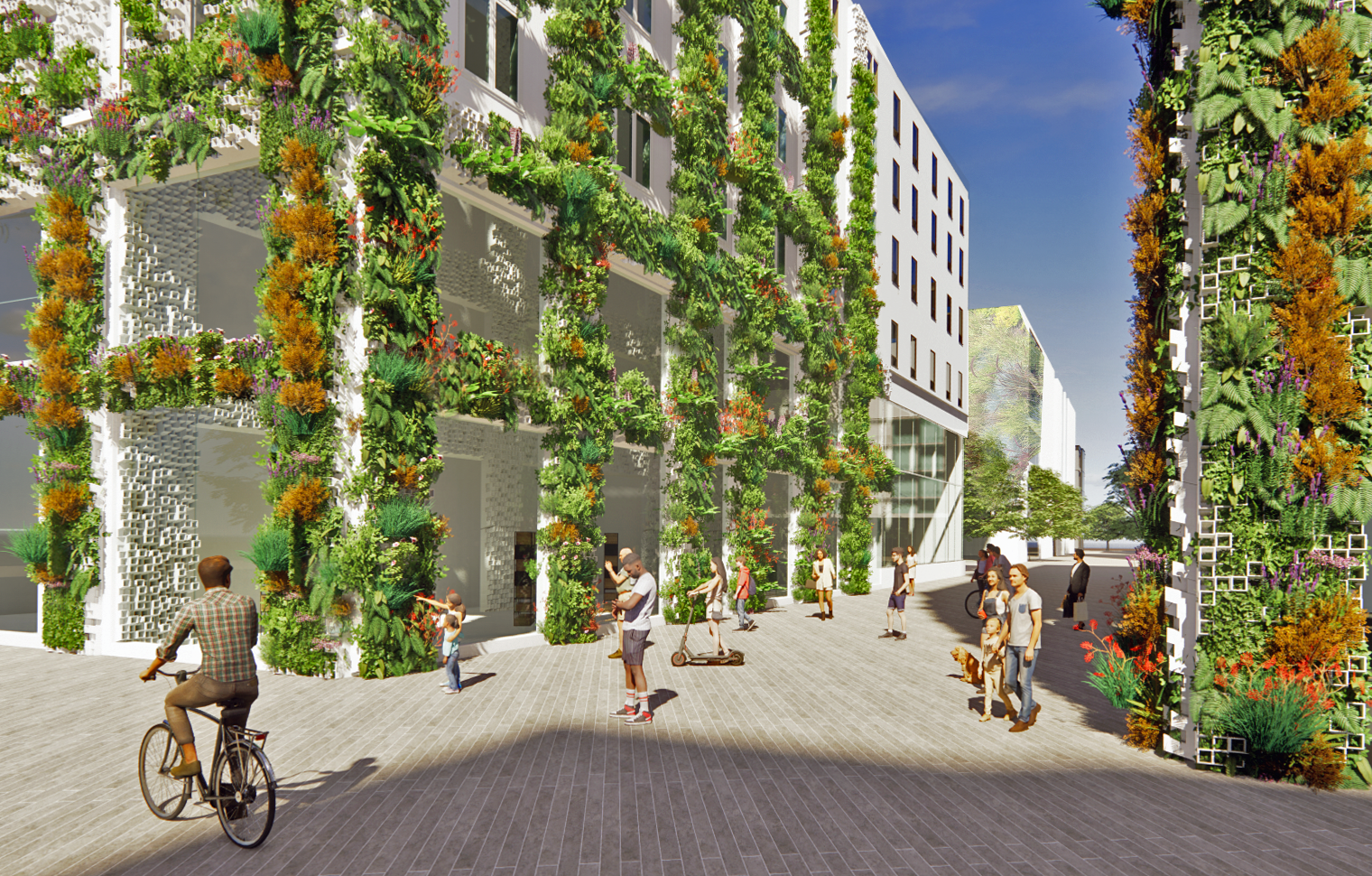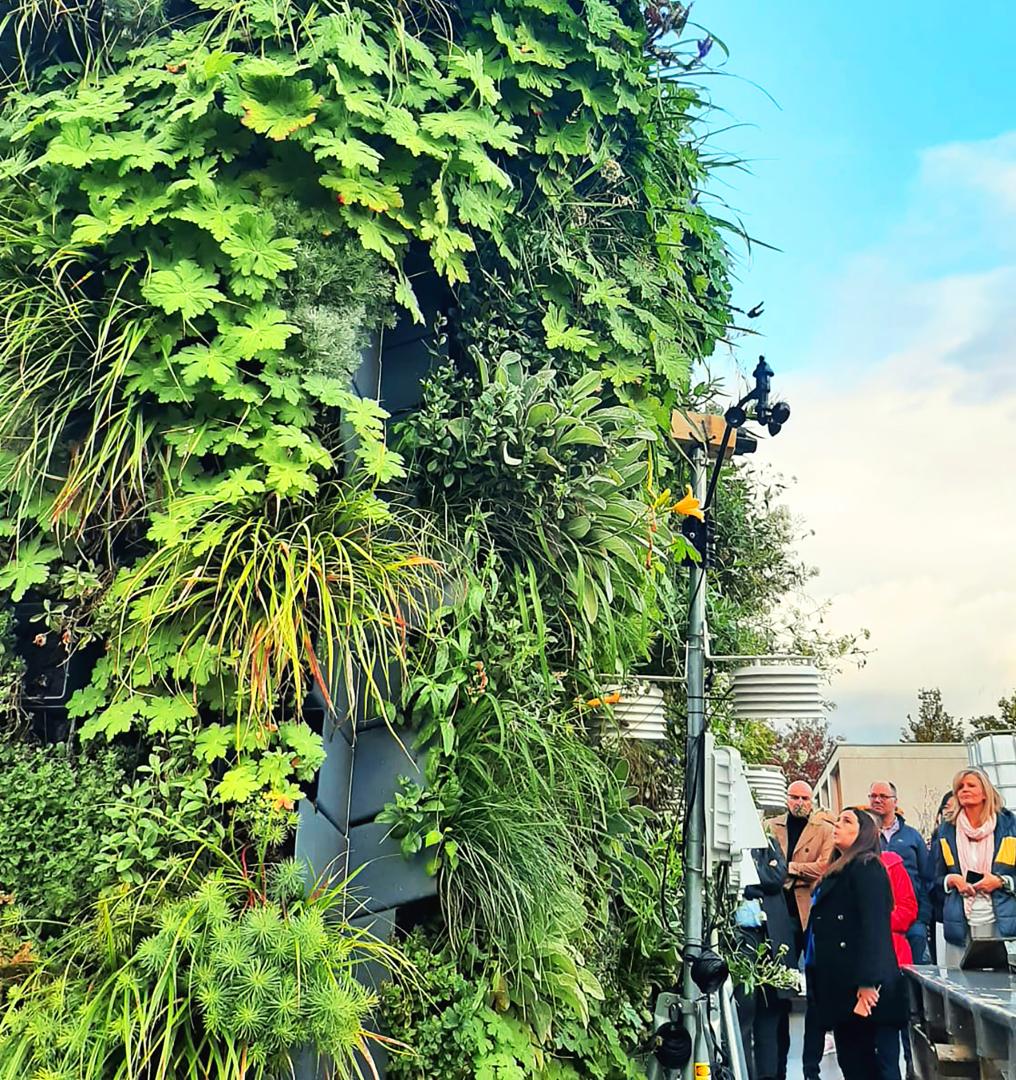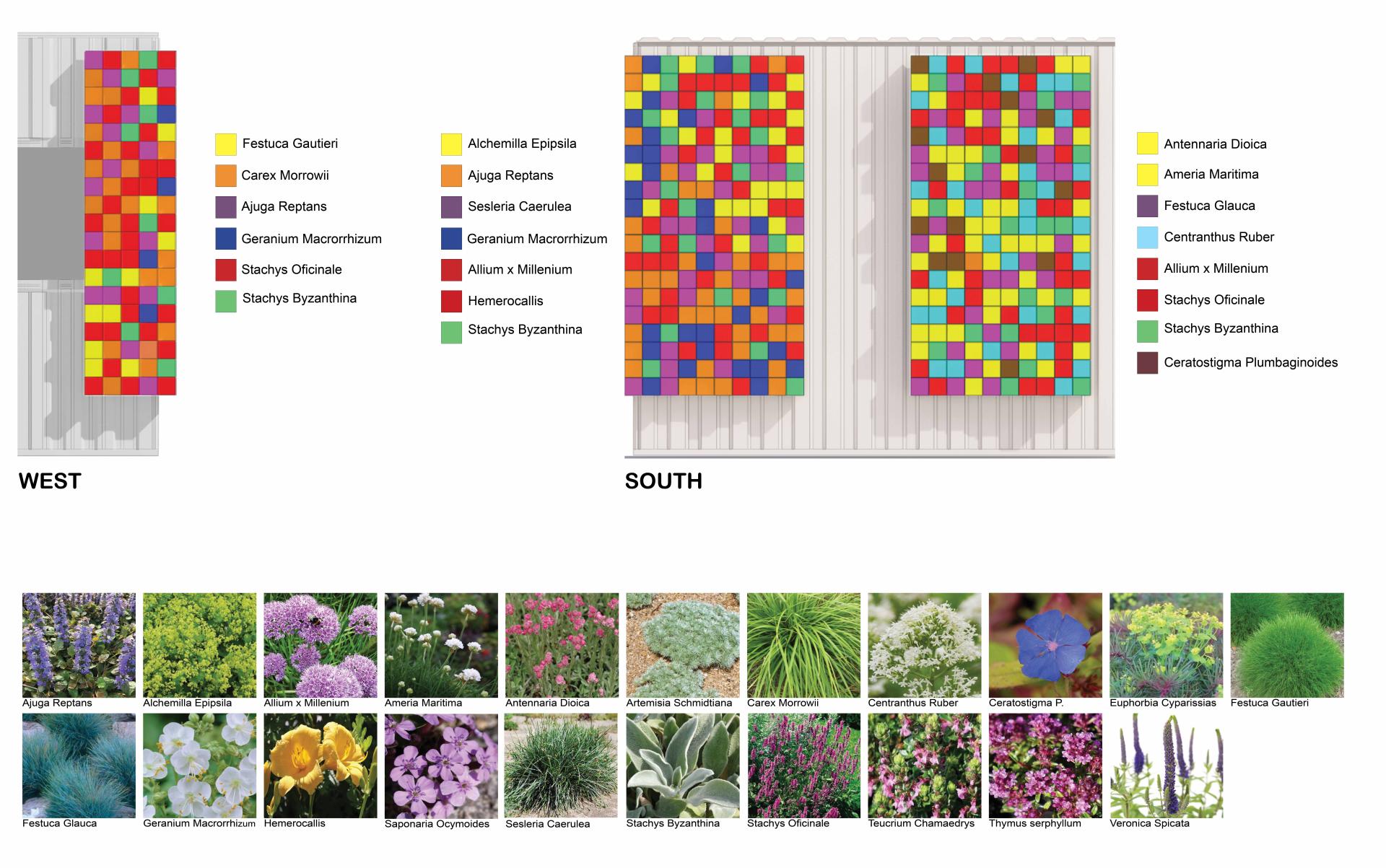Plant Pixel
Basic information
Project Title
Plant Pixel
Full project title
Plant Pixel - The circular living wall
Category
Reconnecting with nature
Project Description
When designed well, green walls enhance sustainability and climate adaptability. The Plant Pixel - a nature-designed green wall - is a modular, low-embodied carbon and cost-effective prototype developed within a circular economy framework. The prototype can help reduce summer temperatures, improving outdoor thermal comfort. Our design provides a sustainable solution for climate adaptation and urban restoration.
Geographical Scope
Local
Project Region
Stuttgart, Germany
Urban or rural issues
Mainly urban
Physical or other transformations
It refers to a physical transformation of the built environment (hard investment)
EU Programme or fund
Yes
Which funds
Horizon2020 / Horizon Europe
Description of the project
Summary
Green façade systems (GFS) can help restore a city’s composition for future habitats - both human and nonhuman. The main objective of this project was to design a bio-inspired low-embodied carbon and cost-effective green façade system to improve urban outdoor microclimate. First, to minimize low embodied carbon and costs in the GFS prototype. Second, to develop a resource-efficient, modular, and adaptable GFS. Third, to assess the ability of the prototype to enhance outdoor microclimate. Fourth, to regenerate natural ecosystems and provide homes for different species.
The prototype, inspired by rock walls, used recycled and local materials to reduce carbon and costs. Plant Pixel stands out from traditional systems with its innovative design, including plug-in modules and varying lengths for irregularities. This adaptability and simplicity ensured affordability, accessibility, and ease of customization, promoting social inclusion and biodiversity. Additionally, it gives designers the power to create their own green facade by arranging the modular cubes like a Lego. Finally, the prototype improved outdoor thermal comfort by reducing summer temperatures by 3.3°C and 1.9°C at 10 cm and 40 cm from the prototype.
Plant Pixel's unique contribution to urban greenery lies in its emphasis on circularity, affordability, and adaptability. Additionally, the Plant Pixel acts as a tool to mitigate the negative impacts of urbanization. Incorporating vegetation into buildings has many benefits, including improved biodiversity, air quality, thermal comfort, health, and well-being. As a result, Plant Pixel provides homes for different species, outdoor thermal comfort, and improved air quality to citizens.
The Plant Pixel provides designers and citizens with a bio-inspired low-embodied carbon and low-cost GFS that can be incorporated into urban areas. The project targets designers, communities, and municipalities seeking nature-based solutions to urban ecological issues.
The prototype, inspired by rock walls, used recycled and local materials to reduce carbon and costs. Plant Pixel stands out from traditional systems with its innovative design, including plug-in modules and varying lengths for irregularities. This adaptability and simplicity ensured affordability, accessibility, and ease of customization, promoting social inclusion and biodiversity. Additionally, it gives designers the power to create their own green facade by arranging the modular cubes like a Lego. Finally, the prototype improved outdoor thermal comfort by reducing summer temperatures by 3.3°C and 1.9°C at 10 cm and 40 cm from the prototype.
Plant Pixel's unique contribution to urban greenery lies in its emphasis on circularity, affordability, and adaptability. Additionally, the Plant Pixel acts as a tool to mitigate the negative impacts of urbanization. Incorporating vegetation into buildings has many benefits, including improved biodiversity, air quality, thermal comfort, health, and well-being. As a result, Plant Pixel provides homes for different species, outdoor thermal comfort, and improved air quality to citizens.
The Plant Pixel provides designers and citizens with a bio-inspired low-embodied carbon and low-cost GFS that can be incorporated into urban areas. The project targets designers, communities, and municipalities seeking nature-based solutions to urban ecological issues.
Key objectives for sustainability
Plant Pixel exemplifies sustainability principles:
Circular Economy principles: The project emphasizes the use of recycled and locally sourced materials within a circular economy framework. In a sustainable innovation, the substrate selected is recycled clothing. By repurposing materials that would otherwise end up as waste, the project follows circular economy principles and reduces carbon.
Modularity and Adaptability: Plant Pixel utilizes plug-in modular components and an adaptable design, allowing it to fit different building facades. Plant Pixel’s plug-in modular system allows for easy assembly and disassembly. Unlike other GFS in the market, the square profile modules are interlocked with the plug-in pipe, instead of screws, to create a Lego-like configuration. This plug-in modular system streamlines installation, reduces labor costs, and enables easy replacement of components.
Focus on Urban Biodiversity: Plant Pixel prioritizes the use of local plant species, promoting urban biodiversity by creating habitats for various species. Various module types were developed for plant growth and to serve as habitats for urban ecosystem inhabitants such as insects, birds, and bats. This approach supports the local ecosystem and enhances biodiversity. Twenty-two plant species were selected allowing for a wide variety of plant species to be installed.
Local Climate Resilience: The Plant Pixel’s cooling effect helps mitigate the urban heat island effect, enhancing local climate resilience. The prototype provides lower summer temperatures, improving outdoor thermal comfort.
Nature Integration: Plant Pixel focuses on integrating greenery into cities, taking inspiration from steep rock walls. This natural inspiration improves both the project's appearance and its hydrological performance. The morphological principles from steep rock walls were abstracted in a pixel-like design. Additionally, plants were selected and arranged, to create visually appealing patterns.
Circular Economy principles: The project emphasizes the use of recycled and locally sourced materials within a circular economy framework. In a sustainable innovation, the substrate selected is recycled clothing. By repurposing materials that would otherwise end up as waste, the project follows circular economy principles and reduces carbon.
Modularity and Adaptability: Plant Pixel utilizes plug-in modular components and an adaptable design, allowing it to fit different building facades. Plant Pixel’s plug-in modular system allows for easy assembly and disassembly. Unlike other GFS in the market, the square profile modules are interlocked with the plug-in pipe, instead of screws, to create a Lego-like configuration. This plug-in modular system streamlines installation, reduces labor costs, and enables easy replacement of components.
Focus on Urban Biodiversity: Plant Pixel prioritizes the use of local plant species, promoting urban biodiversity by creating habitats for various species. Various module types were developed for plant growth and to serve as habitats for urban ecosystem inhabitants such as insects, birds, and bats. This approach supports the local ecosystem and enhances biodiversity. Twenty-two plant species were selected allowing for a wide variety of plant species to be installed.
Local Climate Resilience: The Plant Pixel’s cooling effect helps mitigate the urban heat island effect, enhancing local climate resilience. The prototype provides lower summer temperatures, improving outdoor thermal comfort.
Nature Integration: Plant Pixel focuses on integrating greenery into cities, taking inspiration from steep rock walls. This natural inspiration improves both the project's appearance and its hydrological performance. The morphological principles from steep rock walls were abstracted in a pixel-like design. Additionally, plants were selected and arranged, to create visually appealing patterns.
Key objectives for aesthetics and quality
Nature's inspiration has allowed to progress in both biology and engineering, leading to innovative designs. Our project, the “Plant Pixel,” embodies this concept with a nature-inspired green wall. More specifically, inspired by the morphology of steep rock walls. The modular square profiles create a unique spatial structure in which the irregularities supply shelter and a microclimate capable of allowing numerous plant species to grow. The design promotes movement and versatility in facades. The prototype is appealing and has a high degree of adaptability to the facade of buildings.
The key objectives of the Plant Pixel project in terms of aesthetics and quality of experience more in detail:
Aesthetic Integration: The project prioritizes the seamless integration of greenery into urban landscapes. The morphological principles from steep rock walls were abstracted in a pixel-like design. To mimic the irregularities of steep rock walls, the Plant Pixel design used varied lengths for the square profile modules (W=H and L=110mm-310mm) juxtaposed to reproduce those irregularities. Such as in nature, these irregularities provide shelter and enable numerous plant species to grow. Additionally, with careful selection of plant species and strategic placement, the Plant Pixel creates visually appealing and vibrant green facades. The design emphasizes aesthetics through its design ensuring that it complements the new and existing architecture. By integrating greenery into the built environment, the quality of experience and aesthetics are improved. Therefore, the vegetation and design of the Plant Pixel led users to a sense of well-being.
Quality of Experience: The Plant Pixel project significantly improves the quality of experience for people in urban areas. The presence of green spaces has been proven to have positive effects on mental and physical well-being. By introducing greenery, the project provides a calming and visually stimulating environment.
The key objectives of the Plant Pixel project in terms of aesthetics and quality of experience more in detail:
Aesthetic Integration: The project prioritizes the seamless integration of greenery into urban landscapes. The morphological principles from steep rock walls were abstracted in a pixel-like design. To mimic the irregularities of steep rock walls, the Plant Pixel design used varied lengths for the square profile modules (W=H and L=110mm-310mm) juxtaposed to reproduce those irregularities. Such as in nature, these irregularities provide shelter and enable numerous plant species to grow. Additionally, with careful selection of plant species and strategic placement, the Plant Pixel creates visually appealing and vibrant green facades. The design emphasizes aesthetics through its design ensuring that it complements the new and existing architecture. By integrating greenery into the built environment, the quality of experience and aesthetics are improved. Therefore, the vegetation and design of the Plant Pixel led users to a sense of well-being.
Quality of Experience: The Plant Pixel project significantly improves the quality of experience for people in urban areas. The presence of green spaces has been proven to have positive effects on mental and physical well-being. By introducing greenery, the project provides a calming and visually stimulating environment.
Key objectives for inclusion
The Plant Pixel project’s key objectives in terms of inclusion have been met through accessibility, affordability, and inclusivity. In detail:
Accessibility: Plant Pixel prioritizes accessibility through simple design and construction processes. The simplicity of the technology and construction methods ensures that communities, regardless of their resources or technical expertise, can effortlessly adopt and modify the system. This inclusivity extends to various demographics, including individuals with diverse abilities, as the project’s user-friendly nature allows for widespread participation.
Affordability: The project’s commitment to using locally recycled and inexpensive materials enhances its affordability. By repurposing materials sourced locally, the project significantly reduces costs, making it accessible to communities with limited financial resources. This affordability is crucial for ensuring that GFS are accessible to economically diverse communities.
Inclusive Design: The Plant Pixel project embodies the principles of universal design, ensuring that its benefits are accessible to everyone, regardless of age, ability, or socio-economic background. The project’s adaptability allows it to be tailored to diverse dimensions and requirements identified by the designer or community needs. This flexibility ensures that the system accommodates the needs of all users, promoting a sense of inclusivity and belonging within the community.
Simple Customization: The plant pixel prototype adapts to building facades with a single module of different lengths. Plant Pixel introduces an adaptive design approach, unlike conventional green facade systems with limited adaptability. Its modular structure allows for easy customization, accommodating diverse architectural styles and spatial constraints. As a result, Plant Pixel gives designers the power to create their own green facade by arranging the modular cubes like a Lego.
Accessibility: Plant Pixel prioritizes accessibility through simple design and construction processes. The simplicity of the technology and construction methods ensures that communities, regardless of their resources or technical expertise, can effortlessly adopt and modify the system. This inclusivity extends to various demographics, including individuals with diverse abilities, as the project’s user-friendly nature allows for widespread participation.
Affordability: The project’s commitment to using locally recycled and inexpensive materials enhances its affordability. By repurposing materials sourced locally, the project significantly reduces costs, making it accessible to communities with limited financial resources. This affordability is crucial for ensuring that GFS are accessible to economically diverse communities.
Inclusive Design: The Plant Pixel project embodies the principles of universal design, ensuring that its benefits are accessible to everyone, regardless of age, ability, or socio-economic background. The project’s adaptability allows it to be tailored to diverse dimensions and requirements identified by the designer or community needs. This flexibility ensures that the system accommodates the needs of all users, promoting a sense of inclusivity and belonging within the community.
Simple Customization: The plant pixel prototype adapts to building facades with a single module of different lengths. Plant Pixel introduces an adaptive design approach, unlike conventional green facade systems with limited adaptability. Its modular structure allows for easy customization, accommodating diverse architectural styles and spatial constraints. As a result, Plant Pixel gives designers the power to create their own green facade by arranging the modular cubes like a Lego.
Results in relation to category
The Plant Pixel full-scale mock-up was constructed on the south and west walls of a container in Wolfschlugen, Germany. The full-scale mock-up included 500 square profile modules and 500 plants.
Firstly, this research created an innovative bio-inspired, low-embodied carbon and cost-effective product within a circular economy framework. This represents significant progress in sustainable design and resource management, differentiating it from other GFS products in the market. The Plant Pixel is an innovative GFS that brings vegetation to urban areas, inspired by steep rock walls.
Secondly, the GFS can contribute to adaptation to climate change through the reduction of ambient temperature by intercepting solar radiation and enhancing evapotranspiration. The field monitoring of the cooling effect of the GFS provided empirical evidence of their ability to create more thermally comfortable outdoor urban spaces. Additionally, this GFS prototype provides lower summer temperatures, improving outdoor thermal comfort. The research conducted and the outcome (Plant Pixel) represents a significant addition to climate-responsive design. It uses evidence-based design to help cities adapt to climate change on a larger scale. This project represents a significant step forward towards climate adaptation strategies within urban areas. The innovative low embodied carbon and cost-effective GFS has the capacity to contribute significantly to lowering air and surface temperatures in urban environments. This reduction, in turn, holds the potential to enhance outdoor thermal comfort, hence, positively impacting the health and well-being of urban dwellers.
Thirdly, the project contributes to biodiversity conservation. Biodiversity loss is a global concern with far-reaching ecological consequences. By using local flora and providing habitats for various species, Plant Pixel enhances urban biodiversity. The project prioritizes the seamless integration of greenery into urban landscapes.
Firstly, this research created an innovative bio-inspired, low-embodied carbon and cost-effective product within a circular economy framework. This represents significant progress in sustainable design and resource management, differentiating it from other GFS products in the market. The Plant Pixel is an innovative GFS that brings vegetation to urban areas, inspired by steep rock walls.
Secondly, the GFS can contribute to adaptation to climate change through the reduction of ambient temperature by intercepting solar radiation and enhancing evapotranspiration. The field monitoring of the cooling effect of the GFS provided empirical evidence of their ability to create more thermally comfortable outdoor urban spaces. Additionally, this GFS prototype provides lower summer temperatures, improving outdoor thermal comfort. The research conducted and the outcome (Plant Pixel) represents a significant addition to climate-responsive design. It uses evidence-based design to help cities adapt to climate change on a larger scale. This project represents a significant step forward towards climate adaptation strategies within urban areas. The innovative low embodied carbon and cost-effective GFS has the capacity to contribute significantly to lowering air and surface temperatures in urban environments. This reduction, in turn, holds the potential to enhance outdoor thermal comfort, hence, positively impacting the health and well-being of urban dwellers.
Thirdly, the project contributes to biodiversity conservation. Biodiversity loss is a global concern with far-reaching ecological consequences. By using local flora and providing habitats for various species, Plant Pixel enhances urban biodiversity. The project prioritizes the seamless integration of greenery into urban landscapes.
How Citizens benefit
In future Plant Pixel projects, the collaboration will prioritize engaging directly with local communities. Before this approach was adopted, it was necessary to design and test the project to ensure its viability. We want people to actively participate in designing green spaces in their respective areas. This approach gets the community engaged to ensure the project meets their specific needs and desires, creating a sense of ownership and pride. The engagement with citizens and civil society will be integral to the initiative’s success.
Here’s how citizens and civil society will benefit from the adaptable design and can be involved in the project:
Customized Design: residents can actively take part in the design process of green spaces within their communities. Community meetings and workshops allow citizens to share their ideas on the layout, plants, and appearance. The custom design ensures that green spaces align with community preferences, promoting connection and satisfaction among residents.
Skill Development and Empowerment: In the future, the project can offer training programs and workshops related to the development of the modules and plant selection. Involvement in these initiatives gives citizens the opportunity to play an active role in developing green spaces.
Ownership and Responsibility: People who actively help create green spaces are more likely to value and maintain them. Increased ownership results in better maintenance, guaranteeing the longevity and vibrancy of green spaces.
Community Cohesion: The collaborative design and implementation process enhances community cohesion. By working together on a shared project, residents develop stronger social bonds and a sense of belonging.
Environmental Awareness. By getting involved in green community initiatives, residents can learn about green spaces and the benefits they provide. Increased awareness benefits the lolocal ecosystem and encourages environmentally conscious behavior.
Here’s how citizens and civil society will benefit from the adaptable design and can be involved in the project:
Customized Design: residents can actively take part in the design process of green spaces within their communities. Community meetings and workshops allow citizens to share their ideas on the layout, plants, and appearance. The custom design ensures that green spaces align with community preferences, promoting connection and satisfaction among residents.
Skill Development and Empowerment: In the future, the project can offer training programs and workshops related to the development of the modules and plant selection. Involvement in these initiatives gives citizens the opportunity to play an active role in developing green spaces.
Ownership and Responsibility: People who actively help create green spaces are more likely to value and maintain them. Increased ownership results in better maintenance, guaranteeing the longevity and vibrancy of green spaces.
Community Cohesion: The collaborative design and implementation process enhances community cohesion. By working together on a shared project, residents develop stronger social bonds and a sense of belonging.
Environmental Awareness. By getting involved in green community initiatives, residents can learn about green spaces and the benefits they provide. Increased awareness benefits the lolocal ecosystem and encourages environmentally conscious behavior.
Physical or other transformations
It refers to a physical transformation of the built environment (hard investment)
Innovative character
Circular Economy principles: The project emphasizes the use of recycled and sustainable materials within a circular economy framework. By prioritizing recycled materials and modular, plug-in designs, Plant Pixel reduces waste, promotes reusability, and minimizes its environmental footprint. Unlike other GFS in the market, the square profile modules are interlocked with the plug-in pipe, instead of screws, to create a Lego-like configuration. Plant Pixel’s plug-in modular system allows for easy assembly and disassembly. This plug-in modular system streamlines installation, reduces labor costs, and enables easy replacement of components.
Bio-Inspired Design: The project’s design is inspired by natural formations, specifically steep rock walls. This bio-inspired approach enhances visual appeal. Additionally, it improves hydrological and structural performance by imitating nature's efficiency. Its innovative geometry allows for the accommodation of a wide range of plant species.
Modularity and Adaptability: Unlike conventional green facade systems that offer limited adaptability, Plant Pixel introduces an adaptive design approach. Its modular structure allows for easy customization, accommodating diverse architectural styles and spatial constraints. The modular cubes from Plant Pixel give designers endless creative options. Designers can make each installation visually distinct.
Focus on Urban Biodiversity: Plant Pixel prioritizes the use of local plant species, promoting urban biodiversity by creating habitats
Climate Resilience: Plant Pixel’s impact on outdoor microclimate, particularly its ability to reduce summer temperatures and mitigate the urban heat island effect, demonstrates a forward-thinking approach to climate adaptation and resilience in the face of increasing urbanization and climate change.
Total Cost Reduction: Plant pixel lowers the total cost by considering the entire lifecycle of GFS, including materials, installation, and maintenance.
Bio-Inspired Design: The project’s design is inspired by natural formations, specifically steep rock walls. This bio-inspired approach enhances visual appeal. Additionally, it improves hydrological and structural performance by imitating nature's efficiency. Its innovative geometry allows for the accommodation of a wide range of plant species.
Modularity and Adaptability: Unlike conventional green facade systems that offer limited adaptability, Plant Pixel introduces an adaptive design approach. Its modular structure allows for easy customization, accommodating diverse architectural styles and spatial constraints. The modular cubes from Plant Pixel give designers endless creative options. Designers can make each installation visually distinct.
Focus on Urban Biodiversity: Plant Pixel prioritizes the use of local plant species, promoting urban biodiversity by creating habitats
Climate Resilience: Plant Pixel’s impact on outdoor microclimate, particularly its ability to reduce summer temperatures and mitigate the urban heat island effect, demonstrates a forward-thinking approach to climate adaptation and resilience in the face of increasing urbanization and climate change.
Total Cost Reduction: Plant pixel lowers the total cost by considering the entire lifecycle of GFS, including materials, installation, and maintenance.
Disciplines/knowledge reflected
The Plant Pixel project encouraged interdisciplinary collaboration by combining expertise from different fields through workshops to question assumptions. Academia, ecologists, and engineers took part in workshops, sharing their different perspectives. Workshops and the use of “3D exploration” were effective ways to involve stakeholders in the design process, ensuring a clear understanding of the process among all participants. Within these sessions, experts critically addressed design, plant selection, and the hydrological and structural requirements. Providing a balanced approach to aesthetics, sustainability, hydrological performance, and structural robustness.
By brainstorming with various industries, the designer gains inspiration to solve complex problems with unique perspectives. This approach helped the researcher gain perspectives from both industry and academia, while also providing innovative solutions for GFS to end-users. The project’s end-users include designers, urban communities, local businesses, municipalities, nature enthusiasts, and policymakers interested in fostering urban biodiversity and ecological balance. The collaborative efforts and multidisciplinary approach ensured the Plant Pixel project’s success, creating a sustainable and innovative solution for urban greenery integration.
In conclusion, the interdisciplinary workshops assisted in generating an outcome marked by creativity, and problem-solving abilities. Due to that, trying to solve a problem with different expertise provides unique perspectives. This collaborative approach resulted in a bio-inspired, low-embodied carbon and cost-effective product within a circular economy framework. Additionally, the project enhances urban areas, supports biodiversity, reduces carbon emissions, and ensures longevity.
By brainstorming with various industries, the designer gains inspiration to solve complex problems with unique perspectives. This approach helped the researcher gain perspectives from both industry and academia, while also providing innovative solutions for GFS to end-users. The project’s end-users include designers, urban communities, local businesses, municipalities, nature enthusiasts, and policymakers interested in fostering urban biodiversity and ecological balance. The collaborative efforts and multidisciplinary approach ensured the Plant Pixel project’s success, creating a sustainable and innovative solution for urban greenery integration.
In conclusion, the interdisciplinary workshops assisted in generating an outcome marked by creativity, and problem-solving abilities. Due to that, trying to solve a problem with different expertise provides unique perspectives. This collaborative approach resulted in a bio-inspired, low-embodied carbon and cost-effective product within a circular economy framework. Additionally, the project enhances urban areas, supports biodiversity, reduces carbon emissions, and ensures longevity.
Methodology used
Despite the many developments in GFS research in the past few decades, few projects have investigated the issues of cost-effectiveness, low-embodied carbon materials, hydrological performance, structural performance and microclimate regulation through a bio-inspired design –that presents a holistic GFS design tackling these challenges and that uses nature as a source of inspiration for addressing them.
The RTD process comprehended four steps, divided into two iterations, focused on the following criteria: low-embodied carbon, hydrological and structural performance, simple assembly-disassembly, plant performance, and cost-effectiveness (Figure 1). Steps 1 and 2 represent the first iteration. Step 1, dealt with the design of the GFS prototype, inspired by the morphological characteristics of natural steep rock walls. Step 2, the GFS designs inspired by steep rock walls were evaluated for low-carbon materials, hydrological performance and structural performance using trial mock-ups. Embodied carbon was tested with the Life Cycle Assessment Index, while hydrological and structural performance were tested with water retention, water distribution and maximum water saturation weight.
Similarly, steps 3 and 4 represent iteration 2. Step 3, the GFS prototype was further refined to enhance assembly-disassembly processes and plant species selection. The optimized GFS was implemented in a full-scale mock-up comprising 500 modules and 500 plants, built in Wolfschlugen, Germany. In Step 4, the full-scale mock-up was tested for simple assembly-disassembly, plant performance, and cost-effectiveness. The evaluations entailed assembly-disassembly trials, plant survival rate assessment and a LCCA of the full-scale mock-up. The LCCA included the manufacturing, installation and maintenance phases. Finally, Microclimatic devices were installed next to the GFS prototypes to test its microclimatic effects (ambient temperature, relative humidity, wind speed and solar radiation).
The RTD process comprehended four steps, divided into two iterations, focused on the following criteria: low-embodied carbon, hydrological and structural performance, simple assembly-disassembly, plant performance, and cost-effectiveness (Figure 1). Steps 1 and 2 represent the first iteration. Step 1, dealt with the design of the GFS prototype, inspired by the morphological characteristics of natural steep rock walls. Step 2, the GFS designs inspired by steep rock walls were evaluated for low-carbon materials, hydrological performance and structural performance using trial mock-ups. Embodied carbon was tested with the Life Cycle Assessment Index, while hydrological and structural performance were tested with water retention, water distribution and maximum water saturation weight.
Similarly, steps 3 and 4 represent iteration 2. Step 3, the GFS prototype was further refined to enhance assembly-disassembly processes and plant species selection. The optimized GFS was implemented in a full-scale mock-up comprising 500 modules and 500 plants, built in Wolfschlugen, Germany. In Step 4, the full-scale mock-up was tested for simple assembly-disassembly, plant performance, and cost-effectiveness. The evaluations entailed assembly-disassembly trials, plant survival rate assessment and a LCCA of the full-scale mock-up. The LCCA included the manufacturing, installation and maintenance phases. Finally, Microclimatic devices were installed next to the GFS prototypes to test its microclimatic effects (ambient temperature, relative humidity, wind speed and solar radiation).
How stakeholders are engaged
This Ph.D. project, which is a European Industrial Doctorate (EID) is an example of collaboration from industry and academia. This project, rooted in innovative European research, has been funded by the European Commission under the Horizon 2020 program. The research was performed with the support of the Industrial Partner ZinCo GmbH, in Germany, jointly with Wageningen University & Research, in the Netherlands. Workshops were coordinated with industry, providing invaluable hands-on experience and industry insights. The academic collaboration ensured that the research was grounded in rigorous academic principles, blending theoretical knowledge seamlessly with practical applications.
The methodology employed in this project, Research Through Design (RTD), was instrumental in shaping the outcomes. It offered an iterative design and testing process firmly anchored in clear performance criteria, integrating academic rigor with industrial practicality. This methodical approach resulted in a fully operational and scalable Green Facade System (GFS) prototype known as Plant Pixel, which was constructed and tested in Germany. This collaboration and research methodologies not only emphasize the complexity of the project, but also shed light on the importance of international partnerships in advancing cutting-edge environmental solutions. The Plant Pixel GFS prototype showcases the power of collaborative innovation and interdisciplinary research for a sustainable future.
The methodology employed in this project, Research Through Design (RTD), was instrumental in shaping the outcomes. It offered an iterative design and testing process firmly anchored in clear performance criteria, integrating academic rigor with industrial practicality. This methodical approach resulted in a fully operational and scalable Green Facade System (GFS) prototype known as Plant Pixel, which was constructed and tested in Germany. This collaboration and research methodologies not only emphasize the complexity of the project, but also shed light on the importance of international partnerships in advancing cutting-edge environmental solutions. The Plant Pixel GFS prototype showcases the power of collaborative innovation and interdisciplinary research for a sustainable future.
Global challenges
The specific aim of the Plant Pixel project is to address key global challenges related to urbanization and climate change adaptation at the local level. The project tackles multiple challenges by combining nature and urban environments through an innovative green facade system. Firstly, it tackles the challenge of urbanization, which is a global phenomenon. Integrating greenery into urban spaces is crucial for counteracting issues like the urban heat island effect, pollution, and loss of biodiversity. Plant Pixel provides an adaptable and scalable solution that can be implemented in various urban settings, mitigating the adverse effects of rapid urbanization.
Secondly, the project addresses the challenge of climate change adaptation. Climate change leads to rising temperatures, extreme weather events, and disruptions in ecosystems. The project addresses the challenge of urban heat islands by creating cooling effects through shading and transpiration. Plant Pixel's cooling effects are essential for urban microclimate regulation in a changing climate. By reducing urban heat island effects and enhancing outdoor thermal comfort, it helps communities cope with rising temperatures.
Thirdly, the project contributes to biodiversity conservation. Biodiversity loss is a global concern with far-reaching ecological consequences. By using local flora and providing habitats for various species, Plant Pixel enhances urban biodiversity. A localized approach to biodiversity conservation is crucial, especially in urban areas where natural habitats are often destroyed.
Furthermore, the project addresses the challenge of sustainable development. The project supports the environment by using recycled materials, sustainable design, and promoting circular economy practices. It shows how sustainable technologies can be practical, economically viable, and aesthetically pleasing.
Secondly, the project addresses the challenge of climate change adaptation. Climate change leads to rising temperatures, extreme weather events, and disruptions in ecosystems. The project addresses the challenge of urban heat islands by creating cooling effects through shading and transpiration. Plant Pixel's cooling effects are essential for urban microclimate regulation in a changing climate. By reducing urban heat island effects and enhancing outdoor thermal comfort, it helps communities cope with rising temperatures.
Thirdly, the project contributes to biodiversity conservation. Biodiversity loss is a global concern with far-reaching ecological consequences. By using local flora and providing habitats for various species, Plant Pixel enhances urban biodiversity. A localized approach to biodiversity conservation is crucial, especially in urban areas where natural habitats are often destroyed.
Furthermore, the project addresses the challenge of sustainable development. The project supports the environment by using recycled materials, sustainable design, and promoting circular economy practices. It shows how sustainable technologies can be practical, economically viable, and aesthetically pleasing.
Learning transferred to other parties
Its simplistic design and construction methods enable communities to effortlessly adopt it regardless of their resources or technical expertise. More specifically, easy replication is possible because of the use of simple and affordable technology and machinery. The simplicity of the technology ensures that the Plant Pixel prototype can be tailored to the needs of any community. The project’s adaptable design enables it to fit diverse spatial and community requirements. Therefore, the Plant Pixel can be used as a blueprint to replicate the design in different locations and have a positive impact on diverse communities.
The choice of locally recycled materials decreases the reliance on new materials. Additionally, minimizes the environmental impact associated with material transportation. The choice of inexpensive materials in the Plant Pixel makes the project more accessible to more people.
The focus on using plants to mitigate climate effects provides a replicable model for addressing urban heat stress in numerous cities. The planting scheme designed for low-maintenance, aesthetics, and to decrease temperatures in summer can be adapted to various climates.
Plant Pixel’s design considers climate-related factors such as water retention and thermal regulation. These strategies can be transferred to regions facing similar climate challenges. By tailoring the design to local climate conditions, the project can effectively mitigate climate-related issues in different geographical locations. This vision addresses the urgent need to reimagine urban spaces in response to the climate crisis.
The choice of locally recycled materials decreases the reliance on new materials. Additionally, minimizes the environmental impact associated with material transportation. The choice of inexpensive materials in the Plant Pixel makes the project more accessible to more people.
The focus on using plants to mitigate climate effects provides a replicable model for addressing urban heat stress in numerous cities. The planting scheme designed for low-maintenance, aesthetics, and to decrease temperatures in summer can be adapted to various climates.
Plant Pixel’s design considers climate-related factors such as water retention and thermal regulation. These strategies can be transferred to regions facing similar climate challenges. By tailoring the design to local climate conditions, the project can effectively mitigate climate-related issues in different geographical locations. This vision addresses the urgent need to reimagine urban spaces in response to the climate crisis.
Keywords
nature-based solution
circular economy
bio-inspiration
recycled materials
Design for disassembly

